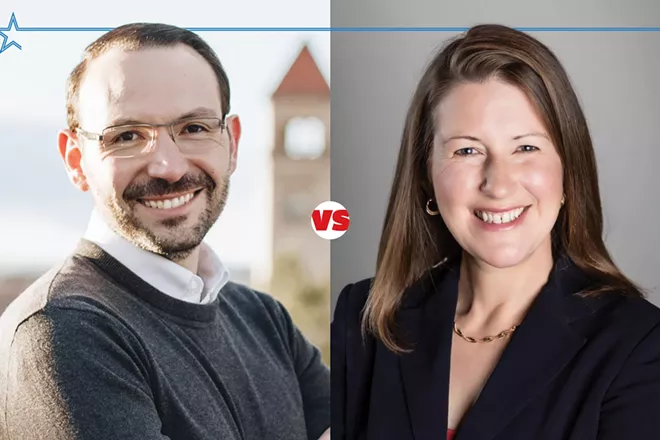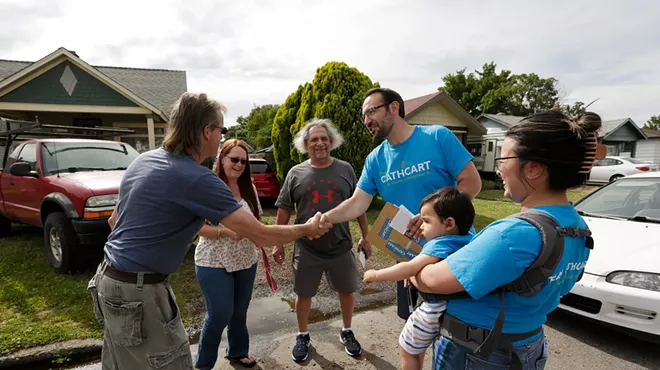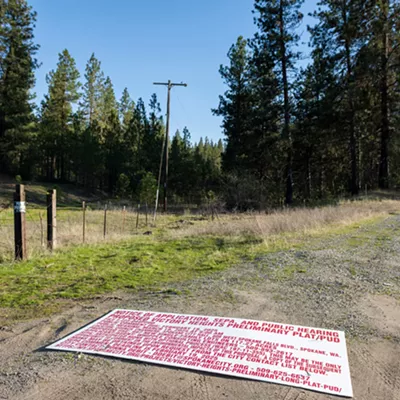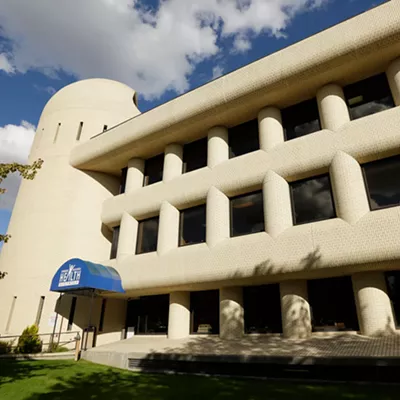In the race for Spokane County Commission's new District 2, which covers east Spokane, Democrat Amber Waldref, 45, faces Republican Michael Cathcart, 36.
Responses to this Q&A have been edited for length and clarity. A shorter version appeared in the Oct. 20 print edition of the Inlander.
INLANDER: Knowing that the commission is likely to have representation from both progressives and conservatives, describe a time you successfully worked with someone you strongly disagreed with politically.
WALDREF: One example of working with someone that probably we disagree on a lot of different issues is [state] Sen. Mike Padden. When I was on City Council, and I was leading the city’s state legislative agenda, one of the things I was championing was supervision of property crime offenders, because we had such a high rate here in Spokane. This really needed to be something that we got state funding for, so I went to Sen. Padden, and we worked with him and we got a bipartisan proposal to get funding for at least a pilot program here in Spokane County for vehicle thefts.
CATHCART: Just about every Monday night. I mean, honestly, we have some pretty strong disagreements, but we also work together quite a bit on a lot of different things. A great example is the Building Opportunity and Choices act. That kind of came out originally when I put forward this idea into the housing action plan. It was kind of mulled over the course of a year-and-a-half and staff worked on it. We all came together and unanimously approved it with strong support from the mayor’s office. The thrust of this is to allow for the development of additional townhomes, which you know, are very efficient when it comes to land use, they provide homeownership opportunities, as well as rentals.
What specific steps should the county commission take to address the housing crisis in the area?
WALDREF: The county has complete control over zoning in any of the unincorporated areas. If there are areas that you could do denser development, like in Wandermere or Southgate or something, as long as it’s consistent with the comp plan, and it’s inside the UGA [urban growth boundary], the county can do that and can make different choices about maybe incentivizing different types of housing. I think the county really needs to engage in true joint planning with the city of the Valley, the city of Spokane, Millwood, whatever adjoining jurisdiction is there, and figure out how those areas that are supported with roads, utilities, schools, where we can further develop those areas.
CATHCART: I mean, you absolutely need to get a commitment from all the different jurisdictions on increasing the level of infill development. Obviously the city, as I just pointed out, made a pretty bold move in that regard. The other part is, we absolutely have to look at where we can appropriately and responsibly expand the urban growth boundary. In the meantime, I believe we need to be looking at where we can make tradeoffs. So areas that are not yet ready to be built, removing them from the UGA and trading with areas that are ready with the infrastructure needs, or the developer is ready to go.
The majority of people in the county jail system are awaiting trial and legally innocent until proven guilty. What major projects or changes should the county implement to address public safety issues?
WALDREF: Over time, we’ve got to figure out how to manage the costs of the jail. There’s pretrial work that you can do, so that’s releasing people before their trial, if it’s safe and appropriate. That helps those people stay connected in the community. While they’re awaiting trial, hopefully they don’t lose their housing, and they keep their jobs, things like that. I’m just a big proponent of evidence-based programs when you can, you know, supervise folks, when it’s appropriate to divert folks to mental health services, to drug and alcohol services, to therapeutic courts. All these things have shown to be more successful in getting folks through the court system in a safe and timely manner.
CATHCART: We need to make sure that we are working together amongst the different jurisdictions, whether it’s the sheriff’s office, the city of Spokane police department, Airway Heights police department, etc. Shared intelligence, I think, is a big one. Could we be doing a better job of reducing, eliminating, identifying criminal activities by working together? This has been a big push of mine at the city, and there’s no reason that we should not be doing the same thing smartly in the right areas, and that is deploying deputies to be on foot and bike patrol in the urbanized portions of the unincorporated county.
How should the county address backlogs in the court system? Should the 13th Superior Court judge approved by the state in 1997 be added?
WALDREF: I’m interested in that, I’m interested in running the numbers on that. I think it would move a lot of cases more quickly through the system that are getting bogged down right now, and which are causing delays and extra costs from everything from pretrial services to jail time and jail costs. I know that there’s a cost associated with it but I think that we could see a return on the investment back to the system if we got that extra judge.
CATHCART: I do believe that we should add that additional judge to Superior Court. Obviously identifying how we’re going to pay for that person and their staff and all the other things that come with it is important. Expeditious pathways to justice are really important. You have a right to a speedy trial, I think victims have a right to see their situations resolved in a speedy fashion as well. So yeah, we need to do everything we can to expedite the process.
Should the sheriff’s office respond to issues with Camp Hope?
WALDREF: We’re going to have a new sheriff soon, and so I guess I’m more interested in the relationship that I can build with a new sheriff and how that sheriff can be working regionally to keep the community safe. Right now, we need to get people housed from Camp Hope. I mean, it never should have happened. It never should have gotten to the point that it is, and I’m certainly hoping that we can get folks into housing, whether it be temporary or permanent, as soon as possible. Why weren’t county and city leaders a year ago prepared to shelter folks? I’m still not sure what the sheriff is planning to do, and so I can’t really speak to that. All I know is, we need to all work together to get people housed.
CATHCART: Yes. There is a significant issue going on within the camp right now. I think the abatement process is absolutely the right direction to go. It frankly should have happened many, many, many months ago. That camp is in my council district, and it is a big frustration because that neighborhood, I believe, has been set backwards by two decades as a result of us allowing that camp, and when I say us, I mean government. We should do everything we can to connect those folks to services, but there has to be some urgency to this. That camp cannot remain through winter.
What do you think are the top three roles that county government serves?
WALDREF: The top three would be, you know, managing and directing criminal justice investments, growth management and land use, and then number three, it would be economic development and workforce. How do those dollars get directed that come through the county in support of long-term economic development goals.
CATHCART: County government is the entity that sets policies that affect the unincorporated parts of the county, so that’s first and foremost. They set the budgets for all of the departments that we work with, so that would be the sheriff’s office, the prosecutor’s office, the treasurer, assessor, auditor, clerk. And then, we also are kind of a quasi-judicial, but executive and legislative branch of government, so it’s not just setting the policy, but it’s also implementing the policy.
Briefly, please answer the following:
Which county department needs more attention?
WALDREF: The planning and building department, because it is so important right now to be identifying ways that we can enhance and direct more housing. I think that department, it’s really critical because every building permit has to go through that department.
CATHCART: I would probably, broadly speaking, say the courts.
Should the local health board include a medical doctor among its members?
WALDREF: Yes.
CATHCART: Yes, I have made that commitment.
Which is more important: a new jail, expanded behavioral health options or another solution?
WALDREF: I would definitely say investing in more behavioral health solutions and strategies. I think I would also say, we’ve got to have a special emphasis on our youth.
CATHCART: What I have called for very specifically is a new jail that includes mental health and drug treatment that would be accessible by the community. Economies of scale.
Does Spokane County’s criminal justice system have an issue with systemic racism?
WALDREF: Per capita, we’re jailing more Black and Native American residents. To me, when there’s data that’s showing that it’s out of proportion, then there’s something wrong with the system.
CATHCART: Not to my knowledge. If there are specific issues within the system, let’s identify what those are and go after them. If you call the entire system racist, then anybody participating in that system is therefore racist, and I just don’t think that that’s accurate.
Who is an unsung hero of county government?
WALDREF: I’ve been really impressed with the parks department at the county led by Doug Chase and his team. I read the recent 2020 county parks master plan, and I think it’s an excellent plan. It’s very detailed. I’m just impressed by how they want to see parks be supported and sustained over time. I think it’s really important for Spokane, because we’re known for our natural open places.
CATHCART: I would say it’s the former chief civil prosecutor Jim Emacio, who was there for 40 years. The amount of time that he put in, and I believe he continues to volunteer his time in support of some of the county operations as well. So I would say it’s him.
What’s a department whose budget we should decrease?
WALDREF: I am not privy to all the budget information yet, so I don’t think I can answer that.
CATHCART: There are absolutely areas that we need to find some areas to reduce costs. What that is, I think, needs to depend upon a broader survey and conversation.
What’s a department whose budget we should increase?
WALDREF: Yeah, it’s also hard to know without a lot of detail. I mean, I know that we’re struggling to keep corrections officers at the jail, and so I would want to look into why that is.
CATHCART: Broadly, it would be the sheriff’s office, because we need to put more officers out on the streets, and that does require some additional funding to accomplish that.
Should the county take the 1 percent property tax hike this year?
WALDREF: I don’t know what the enterprise fund balances are for the county. I don’t really have enough information. I would have to know more to understand what the current financials for the county are to know if it was needed to take the 1 percent.
CATHCART: No.
Should the courthouse tower be open for public tours?
WALDREF: I think that would be great. I don’t see why not. I always thought we should have the clocktower at Riverfront Park open for tours. The challenge is it’s probably a lot of steps.
CATHCART: If it’s feasible to do so, yes. I think that’d be a really cool idea.
What is the best county-run open space or park?
WALDREF: I really think Mirabeau Point is wonderful. The old walk in the wild zoo, that area is incredible, I love going hiking there. You know it’s got the waterfall, the grassy areas where you can picnic, the natural wooded areas. It’s a great park.
CATHCART: I will say it’s the newer aquatic center up in Colbert.
Who is one local politician, past or present, that you admire and why?
WALDREF: I’m gonna say Tim Hattenburg. He’s on the city of the Valley council, and I just have immense respect for him. He is a go-getter. He is a retired educator who decided, “I want to keep giving back to my community.” I think he’s done a great job really promoting important livability issues for the Valley, like parks and open spaces, and trails and planning for schools, and I just think he’s a good collaborator and I enjoy working with him.
CATHCART: I will give you Michael Baumgartner. He gave me a lot of opportunity when I worked for him in the [state] senate and running his campaign. But also I learned quite a bit from him about how to be practical and thoughtful and try to, you know, make the best of a tough situation.
What year did the county government form? (Answer: 1858)
WALDREF: That’s tough. It’s probably after statehood. 1890.
CATHCART: Boy, I want to say 1889, but that’s the year we became a state. I’ll say 1881.
Who was the last Democrat to serve on the commission? (Answer: Bonnie Mager, defeated in 2010 by Al French)
WALDREF: Oh, Bonnie Mager. I know that one.
CATHCART: Bonnie Mager, ’06 to ’10.
How many counties were ultimately divided out from the original Spokane County territory? (Answer: 22; five in Idaho, six in Montana, 11 in Washington)
WALDREF: I’m guessing a lot of Eastern Washington was the original Spokane County territory. Maybe three.
CATHCART: I’ll say two, Stevens and Spokane, but maybe I’m missing one. ♦


























